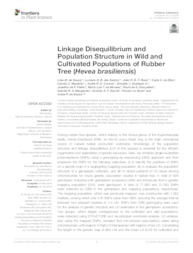Linkage disequilibrium and population structure in wild and cultivated populations of rubber tree (Hevea brasiliensis).
Linkage disequilibrium and population structure in wild and cultivated populations of rubber tree (Hevea brasiliensis).
Resumo: Abstract: Among rubber tree species, which belong to the Hevea genus of the Euphorbiaceae family, Hevea brasiliensis (Willd. ex Adr.de Juss.) Muell. Arg. is the main commercial source of natural rubber production worldwide. Knowledge of the population structure and linkage disequilibrium (LD) of this species is essential for the efficient organization and exploitation of genetic resources. Here, we obtained single-nucleotide polymorphisms (SNPs) using a genotyping-by-sequencing (GBS) approach and then employed the SNPs for the following objectives: (i) to identify the positions of SNPs on a genetic map of a segregating mapping population, (ii) to evaluate the population structure of a germplasm collection, and (iii) to detect patterns of LD decay among chromosomes for future genetic association studies in rubber tree. A total of 626 genotypes, including both germplasm accessions (368) and individuals from a genetic mapping population (254), were genotyped. A total of 77,660 and 21,283 SNPs were detected by GBS in the germplasm and mapping populations, respectively. The mapping population, which was previously mapped, was constructed with 1,062 markers, among which only 576 SNPs came from GBS, reducing the average interval between two adjacent markers to 4.4 cM. SNPs from GBS genotyping were used for the analysis of genetic structure and LD estimation in the germplasm accessions. Two groups, which largely corresponded to the cultivated and wild populations, were detected using STRUCTURE and via principal coordinate analysis. LD analysis, also using the mapped SNPs, revealed that non-random associations varied along chromosomes, with regions of high LD interspersed with regions of low LD. Considering the length of the genetic map (4,693 cM) and the mean LD (0.49 for cultivated and 0.02 for wild populations), a large number of evenly spaced SNPs would be needed to perform genome-wide association studies in rubber tree, and the wilder the genotypes used, the more difficult the mapping saturation.
Ano de publicação: 2018
Tipo de publicação: Artigo de periódico
Unidade: Embrapa Cerrados
Palavras-chave: Comportamento de Variedade, Hevea Brasiliensis, População de Planta, Seringueira, Variação Genética
Observações
1 - Por padrão são exibidas publicações dos últimos 20 anos. Para encontrar publicações mais antigas, configure o filtro ano de publicação, colocando o ano a partir do qual você deseja encontrar publicações. O filtro está na coluna da esquerda na busca acima.
2 - Para ler algumas publicações da Embrapa (apenas as que estão em formato ePub), é necessário ter, no celular ou computador, um desses softwares gratuitos. Sistemas Android: Google Play Livros; IOS: iBooks; Windows e Linux: software Calibre.
Acesse outras publicações
Acesse a Base de Dados da Pesquisa Agropecuária (BDPA) para consultar o acervo completo das bibliotecas da Embrapa.

